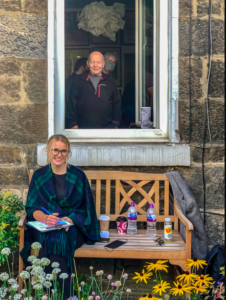Artists in Edinburgh’s Abbeyhill Colonies opened their houses, studios or gardens to show their work in an annual garden party gala at the weekend. I know one of them, Fraser McIntosh, and went along on Sunday. It was a fine autumn afternoon, of swirling white clouds and blue skies and the gardens of these small, Victorian, two-family houses were in full bloom. Someone had made a smiley face in a sunflower that leaned over the footpath.
At the end of the six streets, which were built by a workers’ cooperative of stonemasons in the late 19th century, was an area of food and drink stalls. Some musicians sat around improvising on a traditional air. The local primary school, Venue 38, had a window tribute to local James Tytler, the first man in the UK to ascend in a hot air balloon.
The event was started in 2005 with six artists, by Gill Smith at Venue 23, who modeled it on a similar show in Pittenweem in Fife. It has been getting more popular ever since. More artists have moved to the area and there were 66 involved this year. Gill specialises in jaunty watercolours of the pretty seaside villages of the East Neuk, and was doing a brisk trade in mugs and tea towels, helped by niece Emma Hamilton and a tawny cat, which was sitting between them on a blue arbour-style garden bench.
The studio opposite Gill’s, Venue 22, had a poster reading “Come in, it’s a Circus out there”. Inside was reminiscent of a scene from Jenni Fagan’s Edinburgh-set Gothic horror Luckenbooth. Lorraine Pritchard makes Venetian carnival masks. Venetians sometimes wore full-face masks made out of papier-mache to carnivals, which Lorraine recreates using traditional techniques she learned in Venice and Florence.
“I have always been fascinated by masks”, she said, pointing to a tiny one she made from modeling clay, at 13. Masks with eye and nose covers of the style that were used by plague doctors were also on display. The nose cavity, she said, would be filled with pungent herbs to keep away the smell of death and sickness. It seems the plague doctors believed these masks could help protect them from the ‘miasma’ which they thought carried infection. Maybe they were right – it is certainly reminiscent of our emphasis on mask-wearing today. I decided not to try it out.
Parnian, Ida and Francis walked past a mural of bees and flowers at the London Road end of the colony advertising the event. Parnian was wearing dangly, pink and white earrings by animator James Crang, venue 29. “We are from Edinburgh but we didn’t know about this before. I can’t believe it’s been going on for 16 years.”
Outside Venue 24, Evie Magee sat on a bench below Fraser’s window taking the names and contact details of a steady stream of people, for Track and Trace. A blacksmith and artist, Fraser makes circular powder-coated, metal shelving units – one a large bookshelf – almost all of which had been snapped up by the visitors. I left a heavy bag of groceries in his living room for a short while. When I came back to retrieve it, Fraser said: “I could have sold that. People were enquiring.”

Fraser and Evie. Photo by Gill Robertson
Footnote – the style of these colony houses is of the kind described by Daniel Defoe as being typically Scottish in his account from the early 18th century,
